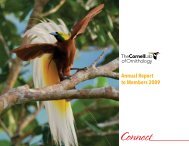National Survey of Fishing, Hunting, and Wildlife ... - All About Birds
National Survey of Fishing, Hunting, and Wildlife ... - All About Birds
National Survey of Fishing, Hunting, and Wildlife ... - All About Birds
You also want an ePaper? Increase the reach of your titles
YUMPU automatically turns print PDFs into web optimized ePapers that Google loves.
Guide to Statistical TablesPurpose <strong>and</strong> Coverage <strong>of</strong> TablesThe statistical tables <strong>of</strong> this report weredesigned to meet a wide range <strong>of</strong> needsfor those interested in wildlife-relatedrecreation. Special terms used in thesetables are defined in Appendix A.The tables are based on responses tothe 2011 <strong>Survey</strong>, which was designedto collect data about participation inwi ldlife-related recreation. To havetaken part in the <strong>Survey</strong>, a respondentmust have been a U.S. resident (aresident <strong>of</strong> one <strong>of</strong> the 50 states or theDistrict <strong>of</strong> Columbia). No one residingoutside the United States (includingU.S. citizens) was eligible for interviewing.Therefore, reported nationaltotals do not include participation bythose who were not U.S. residents orwho were U.S. citizens residing outsidethe United States.Comparability With Previous<strong>Survey</strong>sThe numbers reported can be comparedwith those in the 1991, 1996, 2001, <strong>and</strong>2006 <strong>Survey</strong> Reports. The methodologyused in 2011 was similar to that used inthose <strong>Survey</strong>s. These results should notbe directly compared to results from<strong>Survey</strong>s earlier than 1991 since therewere major changes in methodology.These changes were made to improveaccuracy in the information provided.Trends further back than 1991 arepresented in Appendix C. These trendswere developed using parts <strong>of</strong> the<strong>Survey</strong>s that were comparable.Coverage <strong>of</strong> an Individual TableSince the <strong>Survey</strong> covers many activitiesin various places by participants<strong>of</strong> different ages, all table titles,headnotes, stubs, <strong>and</strong> footnotes aredesigned to identify <strong>and</strong> articulate eachitem being reported in the table. Forexample, the title <strong>of</strong> Table 1 shows thatdata about anglers <strong>and</strong> hunters, theirdays <strong>of</strong> participation, <strong>and</strong> their number<strong>of</strong> trips are reported by type <strong>of</strong> activity.By contrast, the title <strong>of</strong> Table 3 indicatesthat it contains data on freshwateranglers <strong>and</strong> the days they fished fordifferent species.Percentages Reported in the TablesPercentages are reported in the tablesfor the convenience <strong>of</strong> the user. Whenexclusive groups are being reported,the base <strong>of</strong> a percentage is apparentfrom its context because the percentsadd to 100 percent (plus or minus arounding error). For example, Table 1reports the number <strong>of</strong> trips taken by biggame hunters (65 percent), those takenby small game hunters (17 percent),those taken by migratory bird hunters(8 percent), <strong>and</strong> those taken by hunterspursuing other animals (10 percent).These comprise 100 percent becausethey are exclusive categories.Percents should not add to 100when nonexclusive groups are beingreported. Using Table 1 as an exampleagain, note that adding the percentagesassociated with the total number <strong>of</strong> biggame hunters (85 percent), total smallgame hunters (33 percent), total migratorybird hunters (19 percent), <strong>and</strong> totalhunters <strong>of</strong> other animals (16 percent)will not yield total hunters (100percent) because respondents couldhunt for more than one type <strong>of</strong> game.When the base <strong>of</strong> the percentage is notapparent in context, it is identified in afootnote. For example, Table 6 reportsthree percentages with different bases:one for the number <strong>of</strong> hunters, one forthe number <strong>of</strong> trips, <strong>and</strong> one for days <strong>of</strong>hunting. Footnotes are used to clarifythe bases <strong>of</strong> the reported percentages.Footnotes to the TablesFootnotes are used to clarify the informationor items that are being reportedin a table. Symbols in the body <strong>of</strong> atable indicate important footnotes.The following symbols are used in thetables to refer to the same footnote eachtime they appear:* Estimate based on a sample size<strong>of</strong> 10–29.... Sample size too small to report datareliably.Z Less than 0.5 percent.XNot applicable.NA Not available.Estimates based upon fewer than tenresponses are regarded as being basedon a sample size that is too small forreliable reporting. An estimate basedupon at least 10 but fewer than 30responses is treated as an estimatebased on a small sample size. Otherfootnotes appear, as necessary, toqualify or clarify the estimates reportedin the tables. In addition, these twoimportant footnotes appear frequently:• Detail does not add to total because<strong>of</strong> multiple responses.• Detail does not add to totalbecause <strong>of</strong> multiple responses <strong>and</strong>no nresponse.“Multiple responses” is a term used toreflect the fact that individuals or theircharacteristics fall into more than onecategory. Using Table 2 as an example,those who fished in saltwater <strong>and</strong> freshwaterappear in both <strong>of</strong> these totals. Yeteach angler is represented only once inthe “Total, all fishing” column. Similarly,in Table 6, those who hunt forbig game <strong>and</strong> small game are countedonly once as a hunter in the “Total, allhunting” column. Therefore, totals willbe smaller than the sum <strong>of</strong> subcategorieswhen multiple responses exist.“Nonresponse” exists because the<strong>Survey</strong> questions were answeredvoluntarily, <strong>and</strong> some respondents didnot or could not answer all the questions.The effect <strong>of</strong> nonresponse isillustrated in Table 27, where the totaldays <strong>of</strong> hunting is greater than thesum <strong>of</strong> hunting days on private l<strong>and</strong><strong>and</strong> hunting days on public l<strong>and</strong>. Thisoccurs because some respondents didnot answer the days hunted on private/public l<strong>and</strong> questions. As a result,it is known how many days huntershunted but not known if those dayswere on public or private l<strong>and</strong>. In thiscase, totals are greater than the sum <strong>of</strong>subcategories when nonresponses haveoccurred.56 2011 <strong>National</strong> <strong>Survey</strong> <strong>of</strong> <strong>Fishing</strong>, <strong>Hunting</strong>, <strong>and</strong> <strong>Wildlife</strong>-Associated Recreation U.S. Fish <strong>and</strong> <strong>Wildlife</strong> Service <strong>and</strong> U.S. Census Bureau






